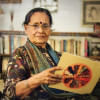The revival of Indigo

Even today, the story entailing indigo farming in the region of Bengal is one of indomitable tyranny and ruthless oppression. When the British rule collapsed, the cash crop almost vanished, leaving behind numerous dilapidated 'Neel Kuthis' (indigo extraction centres). However, the raw potency of indigo was what made its extinction far from possible in this region.
Ruby Ghuznavi, Craft Researcher, Writer and Executive Chairman of Aranya, illustrated the intriguing tale of the rewarding reversal of a remorseful history – indigo's comeback in Bangladesh in the late 1990s.
When Ghuznavi first started learning how to cultivate indigo, at that time in India, the Botanical Garden provided an acre of land for the work. Naturally, owing to the bitter past, the farmers' attitude was resentful towards indigo farming in the primary stages of revival. "I spoke to them and explained that this time, you will not work for the tyrants, you will do it for yourself," recounted Ghuznavi. Instead of being shackles of oppression, this time it would be an opportunity for them to reap the benefits.
The Mennonite Central Committee (MCC) came forward with an interesting initiative – they wanted to involve the Garo community in areas like Tangail in the farming of indigo. Unlike Bengali farmers, they had no such dark history and were quite keen on participating. Thus the MCC went on with the project, and soon began commercial extraction and cultivation of indigo. From then on, Bangladesh started producing and using its own indigo.
Ghuznavi recalls accidentally discovering indigo plantation while working in Kurigram around that time. "Although I didn't have a botanist's knowledge, I was quite intrigued to see such similar plants there and sent some samples to the Botanical Garden," she explained. Soon the results declared that they were indeed the original 'indigofera tinctoria.' The farmers who grew the plants were aware that indigo plants were excellent natural fertilizers (contrary to the common misconception that they make the land infertile). Gradually, MCC and Care were able to approach these farmers and pique their interest to be involved. This time, they were more receptive to the opportunity and with the initiation of Living Blue, indigo farming took off with a renewed zeal.
SIGNIFICANCE OF INDIGO TODAY
As a cash crop, indigo still retains its intrinsic value. Apart from that, it is an 'intercrop', grown in between staples and vegetables, so farmers too can rest assured that it will not take up their entire land throughout the year. Moreover, unlike the production process of synthetic dyes, the one of natural dye's is more labour-intensive, thus generating more employment in the country.
Several countries in Central and Southern America and some regions in India are growing the prized crop, but the harvest is only enough for their own domestic usage. Subsequently there is a huge visible demand for indigo in the worldwide market. "In Bangladesh, we are now growing more indigo than we can use, so it's time we start looking for potential markets," informs Ghuznavi. She further said that so far, Living Blue has been successfully marketing its products and with a more proactive strategy that involves demonstrating the quality of the products, it can gain significant international recognition.
INDIGO IN THE FACE OF COMPETITION
As a natural dye, indigo has already made its mark on the world. Ghuznavi believes as it is our own crop, it has the potential to be exported on a large scale to earn revenue. However, there is severe competition to face with well-established multinationals providing chemical dyes at a much cheaper rate. In addition, she highlighted that sometimes some negative information about natural dyes is disseminated intentionally to disrupt the market force.
"We've been fighting such issues with the quality of our product," Ghuznavi responded firmly. Some people frequently claim that indigo rubs off on the skin, however that occurs very rarely and only when the washing process is not right. She explained that when a sari or dress is being dyed, it needs to be washed well during the production process so that the excess colour can seep out. Furthermore, once bought, they need to be washed carefully with liquid soap instead of detergent (which is actually quite harmful for clothes). These are sold at Aranya at cost price and customers can also take the product back for inquiry in cases of stains.
COMEBACK OF THE CASH CROP
According to Ghuznavi, other Asian countries like Japan, China and Taiwan are currently growing indigo by themselves, but they have a demand for much more. "The market is just at your doorstep and all you need to do is reach out and let them in," she emphasised. If the demand for indigo rises, then supply will consequently follow. Right now, Bangladesh is exporting indigo at a maximum limit, but it has the capacity to produce more. Ghuznavi believes that if we can do so at a larger scale, it will open new dimensions for indigo on a global level. In fact, indigo recently gained international interest as many globally renowned universities are also pushing into its research. "If we cannot grab this golden opportunity, then it will be truly unfortunate," Ghuznavi sighed.
Just last year, a sister organisation of Aranya worked on an experimental project with a group of Garo farmers who were growing and using indigo for themselves. The outcome was quite successful. Ghuznavi believes such projects can help uplift the struggling works of potential producers with training and monetary assistance, so that they can repay once they are established.
Apart from this, she stressed on the importance of knowing a craft to its core before starting a business based on it. While indigo farming and production follows a complex model, it also requires certain amount of capital to start off. "Like every business, you have to keep a far-sighted, risk-taking mentality and cannot expect to start making profits immediately," she furthered and highlighted her journey with Aranya – two initial years of loss, breakeven on the third and finally, profit-making from the fourth year onward.
Ghuznavi warmly invites interested producers to come forward and contact her so that they can strengthen and help each other for the love of the craft. She cheerfully claimed, "You can just never go wrong with blue!" and asserted that all in all, every individual or organisation which wants to grow indigo can expect substantial benefits from it.

 For all latest news, follow The Daily Star's Google News channel.
For all latest news, follow The Daily Star's Google News channel. 





Comments